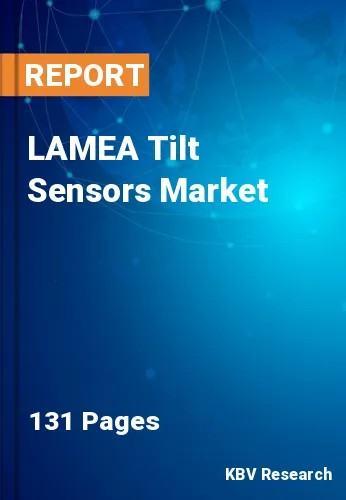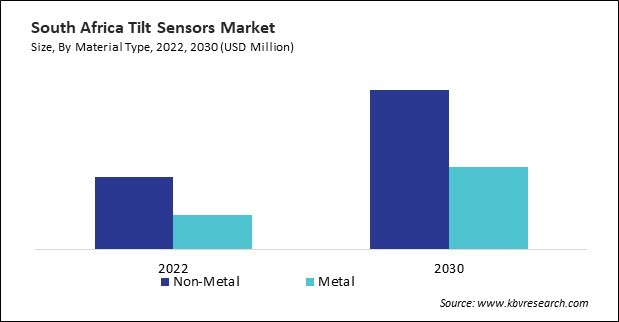
The Latin America, Middle East and Africa Tilt Sensors Market would witness market growth of 10.2% CAGR during the forecast period (2023-2030). In the year 2026, the LAMEA market's volume is expected to surge to 1,216.2 thousand units, showcasing a growth of 12.0% (2023-2030).
These sensors play a crucial role in the construction and mining industries, enhancing the safety, efficiency, and accuracy of various equipment and machinery. In construction applications, these sensors are commonly integrated into heavy machinery such as excavators, cranes, and bulldozers to monitor the inclination of equipment during operation. This ensures stability on uneven terrains, preventing potential accidents and enhancing operator control. In mining, these sensors contribute to the safety and precision of drilling rigs, haul trucks, and other heavy equipment used in extraction and material handling processes. These sensors help maintain proper angles during drilling operations, ensuring accurate and controlled excavations. Therefore, the construction and mining industries within Brazil accounted for a consumption of 105.3 thousand units in 2022.

The Brazil market dominated the LAMEA Tilt Sensors Market by Country in 2022, and would continue to be a dominant market till 2030; thereby, achieving a market value of $8,299.4 Thousands by 2030. The Argentina market is showcasing a CAGR of 10.7% during (2023 - 2030). Additionally, The UAE market would register a CAGR of 9.8% during (2023 - 2030).
These sensors incorporate wireless connectivity options such as Bluetooth, Wi-Fi, Zigbee, and LoRaWAN for seamless integration into IoT and wireless sensor networks. Wireless sensors enable remote monitoring, data logging, real-time alerts, and control capabilities, enhancing flexibility, scalability, and accessibility in various applications.
These sensors adopt low-power design techniques and energy-efficient operation modes to minimize power consumption and extend battery life. Energy-efficient sensors are suitable for battery-operated devices, wireless sensor networks, and IoT applications, where power efficiency is critical for prolonged operation and reduced maintenance. Also, these sensors are increasingly being integrated into edge computing platforms for real-time data processing, analytics, and decision-making at the network edge. By processing sensor data locally, these sensors reduce latency, bandwidth usage, and dependency on cloud connectivity, enabling faster response times and more efficient resource utilization.
Smart manufacturing initiatives in the UAE involve the integration of advanced automation and digital technologies to improve efficiency, productivity, and flexibility in manufacturing processes. As per the International Trade Administration (ITA), in October 2021, the Abu Dhabi Department of Economic Development (ADDED) announced a new Smart Manufacturing initiative to diversify its economy and attract foreign companies. Similarly, the growth of the automotive sector in Saudi Arabia creates opportunities for tilt sensor manufacturers to expand their market presence and reach. According to the ITA, Saudi Arabia accounted for almost 52% of the vehicles sold in the Gulf Cooperation Council (GCC) and 35% in the MENA region in 2020. In conclusion, growing smart manufacturing in the UAE and increasing production of electric vehicles in the region are driving the market’s growth.
Free Valuable Insights: The Worldwide Tilt Sensors Market is Projected to reach USD 426.5 Million by 2030, at a CAGR of 8.3%
Based on Material Type, the market is segmented into Non-Metal and Metal. Based on Technology, the market is segmented into Solid State (MEMS), Fluid-Filled, and Force Balanced. Based on Application, the market is segmented into Construction & Mining, Automotive & Transportation, Aerospace & Defense, Telecommunication and Others. Based on countries, the market is segmented into Brazil, Argentina, UAE, Saudi Arabia, South Africa, Nigeria, and Rest of LAMEA.
By Material Type (Volume, Thousand Units, USD Million, 2019-2030)
By Technology (Volume, Thousand Units, USD Million, 2019-2030)
By Application (Volume, Thousand Units, USD Million, 2019-2030)
By Country (Volume, Thousand Units, USD Million, 2019-2030)
Our team of dedicated experts can provide you with attractive expansion opportunities for your business.
